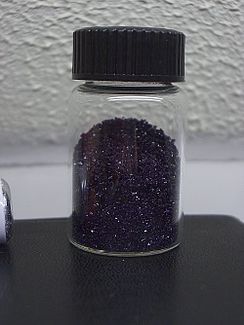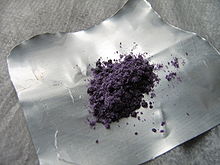- Chrome alum
-
Potassium chromium sulfate  Chromium potassium sulfate[citation needed]Other namesChromium alum[citation needed]
Chromium potassium sulfate[citation needed]Other namesChromium alum[citation needed]Identifiers CAS number 10141-00-1 PubChem 61489 ChemSpider 19968602 EC number 233-401-6 MeSH chrome+alum Jmol-3D images Image 1 - [K]OS(=O)(=O)O[Cr]1OS(=O)(=O)O1
- InChI=1S/Cr.K.2H2O4S/c;;2*1-5(2,3)4/h;;2*(H2,1,2,3,4)/q+3;+1;;/p-4
Key: OIDPCXKPHYRNKH-UHFFFAOYSA-J
InChI=1/Cr.K.2H2O4S/c;;2*1-5(2,3)4/h;;2*(H2,1,2,3,4)/q+2;+1;;/p-4
Key: HIZQQXDAMAATMK-XBHQNQODAZ
Properties Molecular formula KCrS2O8 Molar mass 283.220 g mol-1 Exact mass 282.807677121 g mol-1 Density 1.83 g cm-3 Melting point 89 °C, 362 K, 192 °F
Solubility in water 2.440 kg kg-1 Hazards GHS pictograms 
GHS signal word WARNING GHS hazard statements H315, H319 GHS precautionary statements P305+351+338 EU classification  Xi
XiR-phrases R36/37/38 S-phrases S26 Except where noted otherwise, data are given for materials in their standard state (at 25 °C, 100 kPa) Infobox references Chrome alum or Chromium(III) potassium sulfate is the potassium double sulfate of chromium. Its chemical formula is KCr(SO4)2 and it is commonly found in its dodecahydrate form as KCr(SO4)2·12(H2O). It was formerly used in leather tanning.[1]
Contents
Production and properties
Chromium alum is produced from chromate salts or from ferrochromium alloys. Concentrated aqueous solutions of potassium dichromate can be reduced, usually with sulfur dioxide but also with alcohols or formaldehyde, in the presence of sulfuric acid at temperatures <40 °C. Alternatively and less commonly, ferrochromium alloys can be dissolved in sulfuric acid and, after precipitation of the ferrous sulfate, the chrome alum crystallizes upon addition of potassium sulfate. Chromium alum crystallizes in regular octahedra with flattened corners and is very soluble in water. The solution reddens litmus and is an astringent. Aqueous solutions are dark violet and turns green when it is heated above 50°C.[1] In addition to the dodecahydrate, the hexahydrate KCr(SO4)2·6H2O, dihydrate KCr(SO4)2·2H2O, and the monohydrate KCr(SO4)2·H2O are known.[2]
Uses
Chromium alum is used in the tanning of leather[1] as chromium(III) stabilizes the leather by cross linking the collagen fibers within the leather.[3] However, this application is obsolete because the simpler chromium(III) sulfate is preferred.[2]
It was also used in gelatine emulsions in photographic film.[4]
References
- ^ a b c Holleman, Arnold F.; Wiberg, Egon; Wiberg, Nils; (1985). "Chromium" (in German). Lehrbuch der Anorganischen Chemie (91–100 ed.). Walter de Gruyter. pp. 1082–1095. ISBN 3-11-007511-3.
- ^ a b Gerd Anger, Jost Halstenberg, Klaus Hochgeschwender, Christoph Scherhag, Ulrich Korallus, Herbert Knopf, Peter Schmidt, Manfred Ohlinger, "Chromium Compounds" in Ullmann's Encyclopedia of Industrial Chemistry, Wiley-VCH, Weinheim, 2005.
- ^ Brown, E. M.; Dudley, R.L.; Elsetinow A. R. (1997). "A Conformational Study of Collagen as Affected by Tanning Procedures". Journal of the American Leather Chemists Association 92: 225–233.
- ^ British Journal of Photography, vol 23
External links
Categories:- Sulfate minerals
- Potassium compounds
- Chromium compounds
- Coordination compounds
Wikimedia Foundation. 2010.

